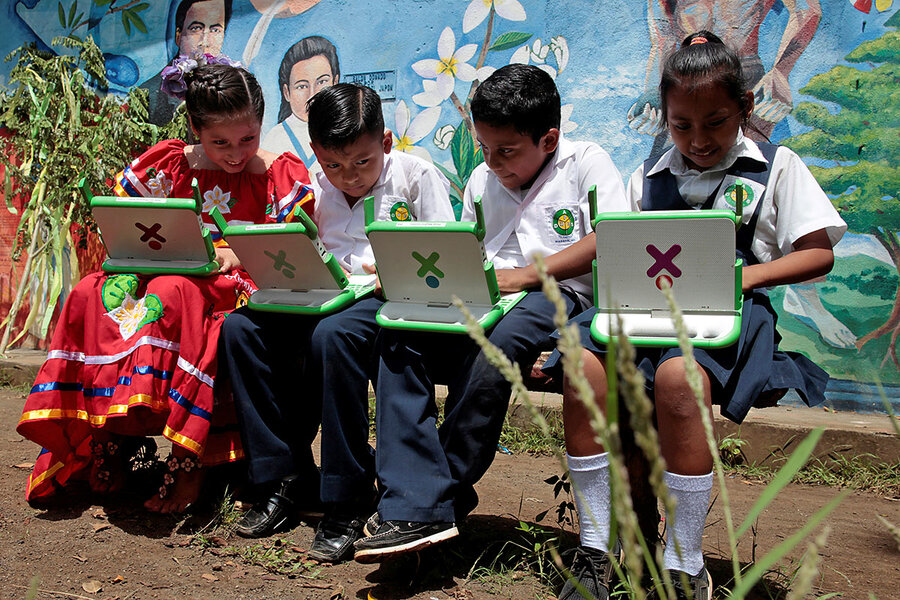Child labor plunges: Millions more children get a childhood
Around the world, millions more children are being allowed to be children.
The number engaged in exploitative and often life-threatening work worldwide plummeted over the past 16 years, according to the International Labor Organization’s most recent progress report on child labor. In 2016, there were 98 million fewer boys and girls forced to work than in 2000.
Broadly, that number translates to millions more children in school and fewer exposed to things like dangerous pesticides and machinery, or trapped in human or sex trafficking.
In 2016, there were 152 million children worldwide who were child laborers, down from 250 million at the turn of the millennium. Behind the drop, experts say, are efforts to get children into school, the enforcement of established labor laws, and programs that boost incomes for poor families. But serious concerns remain: The rate at which boys and girls are being pulled from dangerous work has slowed in the past four years, and experts say that ambitious global targets to end child labor by 2025 appear out of reach.
“Over the last couple of decades there’s been some real progress in reducing the number of children involved in child labor worldwide,” says Jo Becker, advocacy director of Human Rights Watch’s Children’s Rights Division. “We called the new report a wake-up call because we feel like it shows that progress is possible, but we really need to pick up the pace.”
Ms. Becker says the slowdown has been driven by a number of factors including the Syrian civil war, which displaced millions of children. And there are concerns that the remaining child workers are proving harder to extract as government crackdowns push them out of regulated industries, such as factories, and into the shadows.
“We always have a concern that if we succeed in getting children out of one sector, they will be forced into something worse – and sexual trafficking is something worse,” says Reid Maki, coordinator of the Child Labor Coalition.
The US Department of Labor (DOL) published a report in September also analyzing child labor around the world in 2016.
One troubling trend: In sub-Saharan Africa, the rate of child labor actually is increasing. For example, in Burkina Faso, South Sudan, Cameroon, and Chad, more than half of all children between the ages of 5 and 14 are involved in child labor. Many children in these countries are involved in what the DOL refers to as “the worst forms of child labor,” such as human trafficking or sexual trafficking.
But international progress is evident: Of the 135 countries covered in the report, 61 percent achieved “moderate” or “significant” advancement and only 6 percent showed no progress whatsoever.
Some of the countries that made significant advancement took measures to ensure labor laws were strictly enforced. For example, Albania increased funding for labor inspectors, Ecuador increased its number of inspectors by 67 percent, and Brazil launched 950 investigations into commercial sexual exploitation of children.
“While passing good laws and ratifying established conventions are rarely easy and always commendable,” says the DOL report, “laws – even the most perfectly crafted statutes – are meaningless if they are not enforced.”
Nicaragua and Egypt made moderate progress through investments in education. Although education is free in Nicaragua, families often struggle to cover associated costs such as school supplies. To combat these barriers, the Ministry of Education invested in its school supply program, which provided 3.9 million textbooks and 700,000 packages of school supplies to children. Egypt created a new program to expand education to 36,000 additional students and supported a feeding program that served 13.3 million students.
Boosting adult wages can also help more children have a childhood. Companies around the world need to ensure they are paying their low-level employees a respectable salary, says Mr. Maki, meaning they are less likely to send their children to work.
“[Companies] need to be willing to make a little less money and have a clean supply chain – and customers want that,” says Maki. “If you ask, ‘Are you willing to pay more for something that doesn’t have child labor?’ customers say, ‘Yes.’ ”






